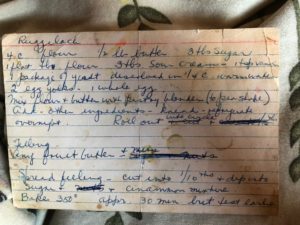How to Bake Ruggelach with Mom

- Dig through the ratty blue file folder you keep your oldest recipes in. Inside, find a lopsided mess of stacked, stained, crispy, ancient papers. They’re not organized into neat categories, or any categories; they’re just shoved in there with no rhyme or reason. But you like it the way it is. You like that it smells musty like old flour and spilled yeast, dried soy sauce and sprinkles of cayenne. Some of these recipes you’ve been carrying in the same old blue folder for over thirty years. Including the one you’re looking for now. You know what it looks like. It’s on a small stained white index card with pale blue lines, written in your mother’s handwriting with a cheap ballpoint pen—and the word Ruggelach is in cursive at the top.
2. Buy all the ingredients the day before you need them, although many of them are common things you always have on hand—like butter and flour, cinnamon and usually, walnuts.
3. Make a list of the special ingredients needed just for this recipe. Like yeast. You may have some leftover in the door of your refrigerator, but since it’s been there since the last time you made bread, it’s probably expired. Buy new yeast and think for the umpteeth time, “Why can’t I just buy it one packet at a time?” Enjoy the fact that the yellow and red packet of Fleischman’s yeast looks exactly the same as it did when you pushed the shopping cart for your mother (“Not too fast, Laurie!”) in the A&P market back in Long Branch, New Jersey.
4. Wonder what kind of interesting jellies or marmalades you’ll find this year. Feel nostalgic for the Lekvar Prune Butter that your mother always used when you were a little girl. Wonder if Lekvar Prune Butter still exists on the east coast, in Orthodox Jewish neighborhoods, or anywhere in the world at all. Remember that your mother’s second favorite jam was apricot, which you can still buy. Go to the store and look for something interesting—blueberry, peach, cherry. Get some Nutella because your daughter Lizzy loves her ruggelach with Nutella.
5. Buy the smallest container of sour cream you can find. This is something you never keep in the house or eat, except as an ingredient in this particular dough. After you use the tablespoon you need for the recipe, it will grow a bulls-eye of mold in your refrigerator. It does this every year.
6. Bring your ingredients home and call your mother. “Mom,” you say, “I’m making the dough for ruggelach.” When she replies, “That’s nice, dear,” without any real enthusiasm or interest, realize that this may very well be the last time you make ruggelach together.
7. Make the dough following the ingredient list written in faded text (kind of like an old tattoo) on the small index card. Use the wooden handled implement with four thin rounded wires on the bottom, the one you got from your mother, the one that looks so old that you think she might have gotten it from her mother. You have no idea what this tool is called, but you know how to use it. Use it now to mash up the softened butter and flour, with a tablespoon and half of sugar thrown in. Savor the feeling of the thin metal strands cutting through the soft butter. Keep slicing into the mixture again and again, until it reaches the consistency of soft peas and is thoroughly blended together. Add two egg yolks, and a teaspoon of vanilla (which you always have on hand—this time a pint you carefully triple-wrapped in plastic and carried all the way back from Mexico).
8. Once the dough is smooth and of earlobe consistency, knead it lightly for a minute or two. Then use a sharp knife and cut it in quarters. Remember when you were too young to use the knife and you had to stand up on a little step-stool in the kitchen and wait for your mother to do it. Take each of the four quarters and roll it into a round ball in your hand. Wrap each ball in saran wrap and place the four balls in the refrigerator to chill overnight.
9. The next day, go over to Sunshine Villa where your mother lives (after talking to her at least six times on the phone to remind her when you’re coming) and help her and her new red walker into the car. Drive to your house and steady her as she makes her way over your uneven front path and up the one step to get to your front door. Open the door for her.
10. Once you get in the kitchen, help your mother into an apron and help her sit at the kitchen table. Bring her a glass of water while she catches her breath. Take the balls of dough out of the refrigerator so they can begin to soften.
11. Poke your head in your daughter’s room and ask if she can help make ruggelach for a little while. When she hesitates, tell her how much it will mean to her grandmother. Smile when she says she’ll be out in a few minutes. “Close the door behind you, Mom,” she says. You pull the door, tight, just the way she likes it. Remember the day when she was nine and you took the door off its hinges after she refused to stop slamming it over and over again. That shocked the hell out of her. Natural consequences.
12. Preheat the oven to 350. Pull out two cookie sheets and grease them with the leftover wrappers from the butter you used. Smile when you realize you always save those wrappers, just like your mother.
13. Carefully wipe off the kitchen table. Remember how when you were little, you’d see your mother wipe the scraps on the table into her hand and how gross that seemed to you. “Ewww,” you’d say, “How can you do that?” Smile at that memory as you wipe the sponge across the yellow and white Formica table, letting the crumbs drop into your waiting palm.
14. Dry the table with a dishtowel and lift down the heavy ceramic flour canister. Dust the top of the table with a sprinkling of flour as your mother used to do. Notice how empty your mother’s face looks today. Wonder what she’s thinking about. Wonder if she’s thinking about anything at all.
15. Get out your jars of jam and the Nutella. Get the bag of walnuts from the freezer. Pull down the nut grinder, the new one that’s made of glass. Remember the dented metal one with speckles that you used in your mother’s kitchen when you were a little girl. Put some walnuts in the top of the grinder and put it in front of your mother. Watch her shaky hands grind the nuts. Oh good. Something she still can do.
16. Get out a flat bowl and fill it halfway with cinnamon and sugar. Stir together until they’re a uniform light crusty brown. Set aside.
17. Pull out your marble rolling pin and flatten the first circle of yellow dough on the table. Stand up to throw your weight into it. Know that this is one part of the job you’re going to have to do yourself. Mom can hardly stand up, no less roll out dough.
18. When the dough is thin and round, get out a spatula and take a dollop of blueberry jelly and spread it thinly onto the surface of the circle, all the way out to the perimeter. Ask Mom to sprinkle on the nuts. Help her open the top of the grinder. Urge her to use a little more nuts. You’ve been urging her to sprinkle on more nuts for the last 50 years. “Walnuts are expensive,” she always used to say.
19. Remember all the other things you and your mother used to bake—Jan Hagel cookies, Congo squares, sour cream coffee cake, tollhouse chocolate chips, peanut butter cookies. You used to get to press down on each cookie with a fork, two different ways, to make the signature criss-cross pattern on top.
20. Remember how your mother used to let you play in the kitchen—making concoctions with your friend Mindy that you’d dare each other to drink—apple juice with Tabasco and salt and brown sugar and green food coloring. Remember how your mother taught you that garlic and onions cooked in olive oil were the basis of all good cooking. Remember how she taught you to always serve food in a bowl that was just the right size—so the dish looked like it was full, almost overflowing, so it always looked like there was plenty.
21. Once the jam and chopped nuts are spread evenly to the very edges of the dough, take a steak knife and cut the circle in half with one long steady swipe of the blade. Then cut it in half again. Keep cutting each section in half until you have 16 long triangles sitting on the table, the points at the ends still touching in the middle.
22. From either side of the table, in unison, you and your mother begin to roll up each long triangle, starting at the outside edge and working toward the middle. As you roll, you pull the dough slightly as your mother taught you to do, so that the rolled cookie is tight. Your mother rolls hers loosely and unevenly so that the jam and nuts fall out of the side. Don’t say anything. Both of you toss your rolled cookies into the waiting cinnamon and sugar. Periodically, roll each cookie in the mixture until it’s coated on all sides and then place them on to the greased cookie sheets, making sure each cookie has room to expand.
21. When the first cookie sheet is full, slide it into the oven. Then go knock on your daughter’s door, with just a hint of guilt embedded in the rap of your knuckles. You hear, “Okay, Mom!” from inside. That and the annoyance in your daughter’s voice. But two minutes later she emerges, all smiles for her grandma. “Hi Grandma,” she chirps. Then she walks over to the table, sprinkles some more flour and begins to roll out the second ball of yellow dough.
22. Watch your mother light up as she looks at her shana madela, her beautiful granddaughter. “I think you got taller,” she says. “You’re so beautiful.” Watch your mother stare at her granddaughter and take in her curvy, luscious body, just the way she used to stare at you.
23. Remember how much you hated it when your mother talked about your looks, your weight, your breasts, and your body. Remember how much you cringed when she looked at you appraisingly and offered her opinion of your changing body. Realize, once again, that your mother is incorrigible. It’s too late for her to change. She will never stop doing this, no matter how many times you ask her not to talk about your daughter’s body.
24. Notice that your daughter doesn’t seem to mind. This is your wound, not hers.
25. “Mom,” your daughter asks, as she presses down on the rolling pin, trying to find her rhythm. “Did you get Nutella?”
26. “Of course, I did,” you say. You like to make your daughter happy, just like your mother used to make you happy. Not necessarily in the big ways—those aren’t in your control—but in the small, daily ways, like buying her Cinnamon Toast Crunch and Honey Nut Cheerios, even though they’re unhealthy and you never eat them. Enjoy her smile as she sees the jar of Nutella, ready and waiting on the table.
27. “Is this thin enough?” your daughter asks as she stands back and surveys her work. In response, take the rolling pin and spread the dough a little thinner and make it a little more even, a little more round. Watch as your daughter spreads the Nutella (which is a lot harder to spread than jelly). Remember that she likes tiny chocolate chips in it too, and get those of out of the freezer, leftover from the last time you baked together. Sprinkle some of those on the Nutella along with the walnuts. Slice this batch of ruggelach as before. This time, with three of you rolling the long sticky triangles, two more trays are quickly filled.
28. Repeat with the third and the fourth balls of dough. Take the ruggelach out of the oven after half hour, when they are golden brown and before the sticky sugar on the bottoms burn to the trays. Use a spatula to loosen them and put them on a rack to cool.
29. When all the ruggelach are out of the oven, your mother says, “I need to lay down.” Help her walk into the living room and give her today’s newspaper, knowing she’ll be asleep in moments. Thank your daughter and watch her disappear into her room and pull the door tight. Savor the smell in the kitchen, and the women stretching behind and before you, as you wash the dishes and wipe the last crumbs from the days’ baking into the palm of your hand.
This story was first published in Eat, Darling, Eat.
———
 Laura Davis is the author of The Burning Light of Two Stars: A Mother-Daughter Story, the story of her loving yet tumultuous relationship with her mother, and six other non-fiction books. Her first books, The Courage to Heal and The Courage to Heal Workbook, paved the way for hundreds of thousands of women and men to heal from the trauma of sexual abuse. Becoming the Parent You Want to Be, a rich resource guide co-authored with parenting expert Janis Keyser, helped parents develop a vision for the families they want to create. I Thought We’d Never Speak Again: The Road from Estrangement to Reconciliation taught the skills of reconciliation and peace building, one relationship at a time. Laura’s groundbreaking books have been translated into 11 languages and sold two million copies.
Laura Davis is the author of The Burning Light of Two Stars: A Mother-Daughter Story, the story of her loving yet tumultuous relationship with her mother, and six other non-fiction books. Her first books, The Courage to Heal and The Courage to Heal Workbook, paved the way for hundreds of thousands of women and men to heal from the trauma of sexual abuse. Becoming the Parent You Want to Be, a rich resource guide co-authored with parenting expert Janis Keyser, helped parents develop a vision for the families they want to create. I Thought We’d Never Speak Again: The Road from Estrangement to Reconciliation taught the skills of reconciliation and peace building, one relationship at a time. Laura’s groundbreaking books have been translated into 11 languages and sold two million copies.
In addition to writing books that inspire and change people’s lives, the work of Laura’s heart is to teach. For more than twenty years, she’s helped people find their voices, tell their stories, and hone their craft. Laura loves creating supportive, intimate writing communities online, in person, and internationally.
Laura loves meeting with her readers and believes that a book is meant to be a collaborative conversation between author and reader. She loves the unpredictable and often intimate conversations that occur when readers bring their own family stories and life experience to the books she has written.
You can learn about Laura’s books and workshops, read the first five chapters of her new memoir, and receive a free ebook: Writing Through Courage: A 30-Day Practice at www.lauradavis.net.
- Welcome to the December 2024 Cover Issue of the Pulpwood Newsletter! - December 1, 2024
- New Author Members – November 2024 - December 1, 2024
- Welcome to the November 2024 Cover Issue of the Pulpwood Newsletter! - November 2, 2024
- New Author Members – October 2024 - October 31, 2024
- Welcome to the October 2024 Cover Issue of the Pulpwood Newsletter! - October 1, 2024
- Welcome to the September 2024 Cover Issue of the Pulpwood Newsletter! - September 1, 2024
- New Author Members – August 2024 - August 19, 2024
- Welcome to the August 2024 Cover Issue of the Pulpwood Newsletter! - August 5, 2024
- New Author Members – July 2024 - July 30, 2024
- Welcome to the July 2024 Cover Issue of the Pulpwood Newsletter! - July 1, 2024




